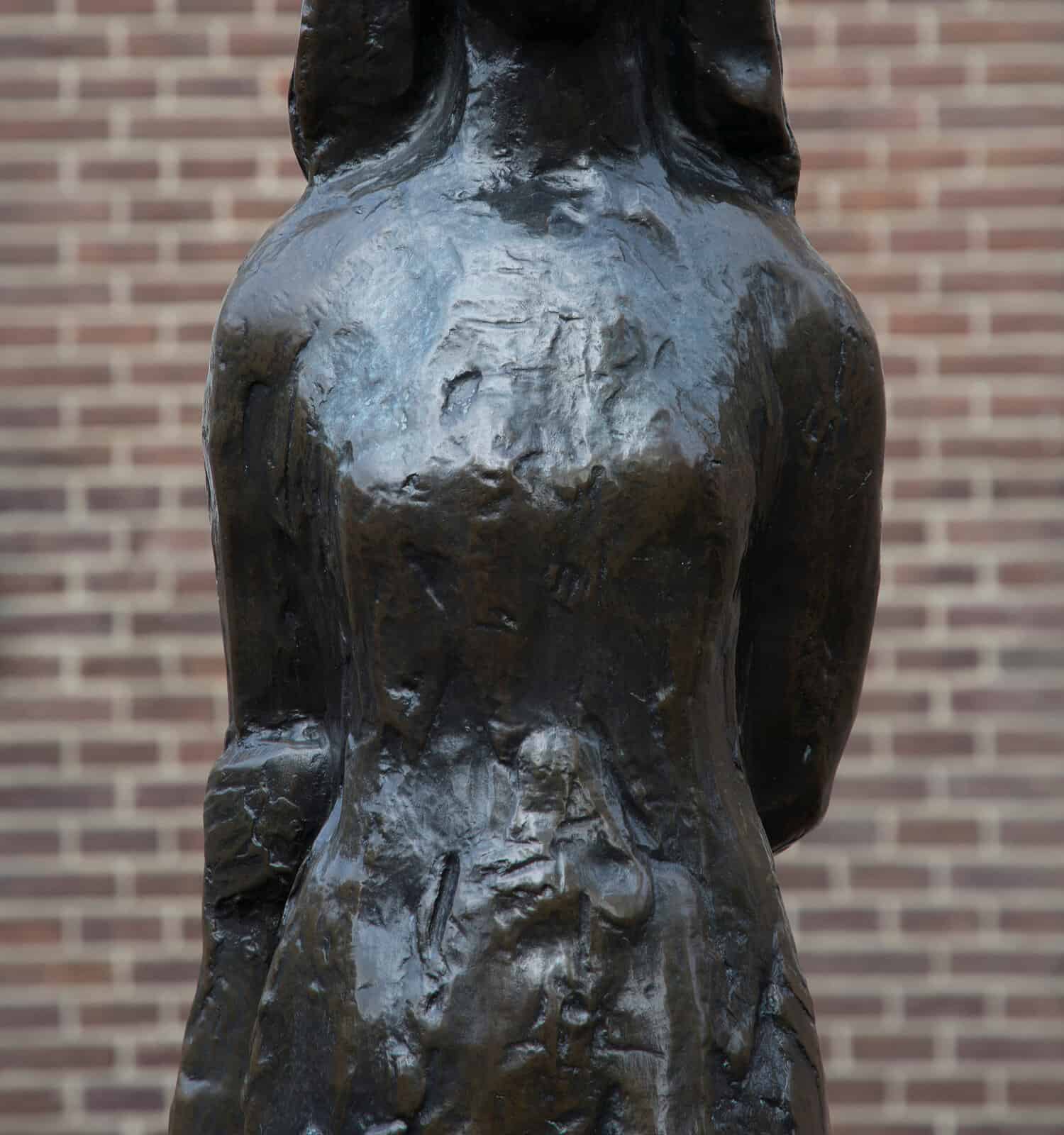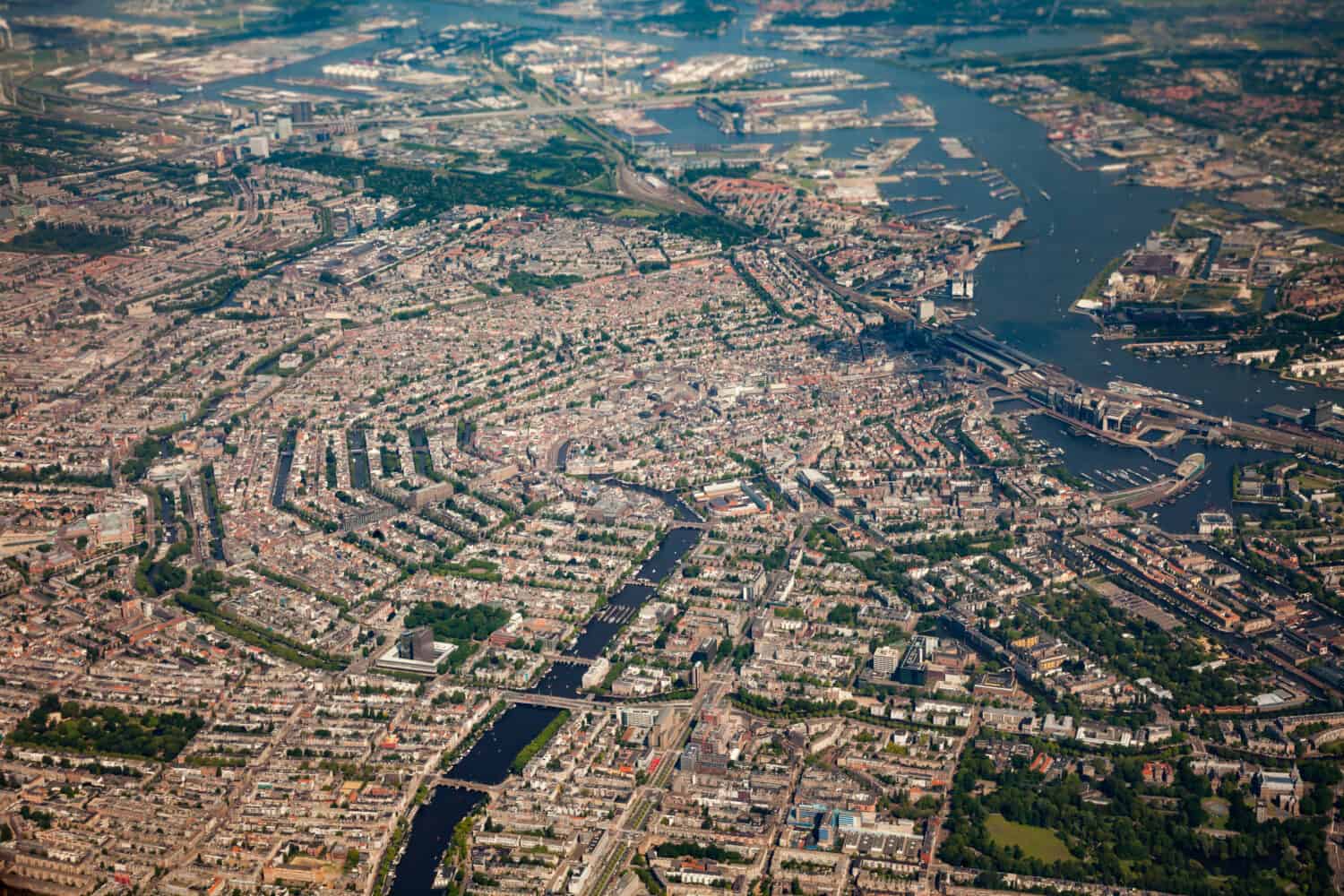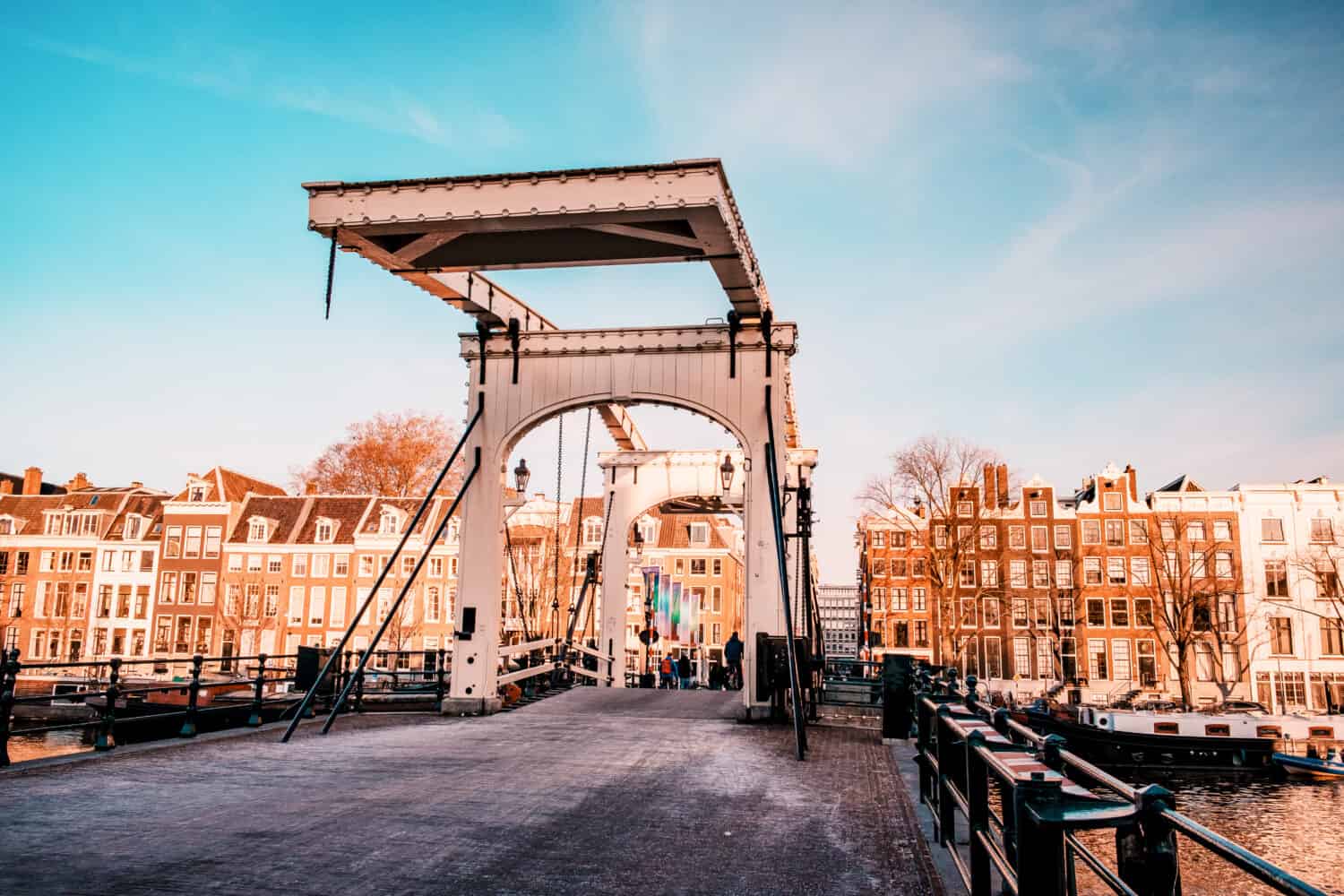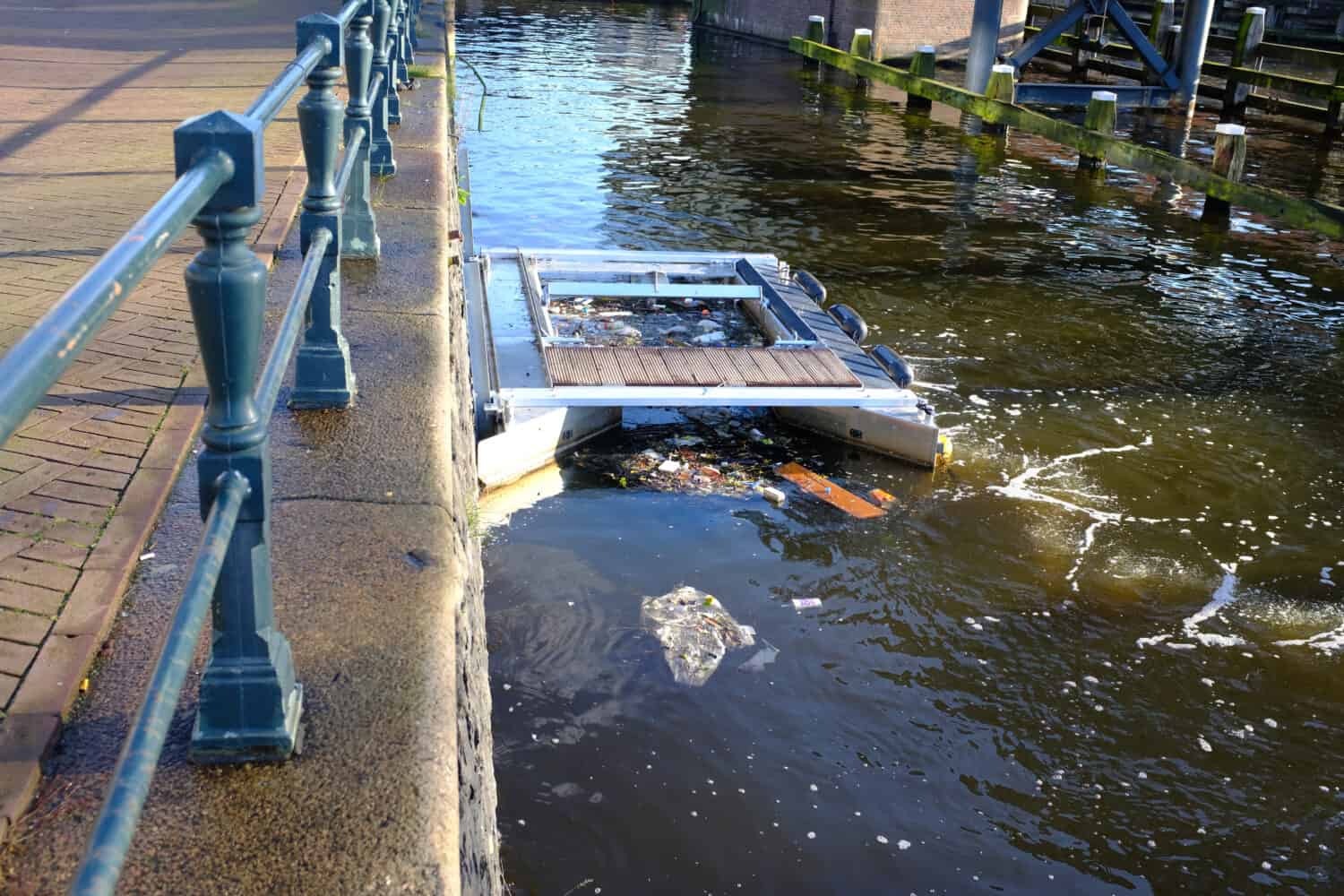Widely recognized as the “Venice of the North,” Amsterdam is a city where historical grandeur and modern practicality effortlessly intertwine. The capital of the Netherlands, the city is one of the richest in Europe. Yet Amsterdam has resisted giving up what makes it the city it is. Amble along cobblestone streets and you’ll pass by artfully crafted gabled houses that seem to lean into each other like whispered secrets. Turn the corner and you’ll encounter contemporary art galleries, tech start-ups, and innovative top-tier culinary scenes. What holds these disparate worlds together is the Amsterdam’s complex network of canals.
Before diving deeper into the canals, literally and metaphorically, let’s take a step back to explore their historical significance.

If Amsterdam had remained a small fishing village, it may now resemble Volendam, a town in North Holland, Netherlands.
©Resul Muslu/Shutterstock.com
The History and Evolution of Amsterdam’s Canals
Amsterdam’s Rise from a Small Fishing Village to a Global City
You’d hardly believe that Amsterdam started as a modest fishing village in the 13th century. But we all start somewhere. Centuries later, when the way of water dictated regional, and perhaps even global, power, the superior sail often won. In the early 17th century, during what is often called the Dutch Golden Age, Amsterdam experienced an economic upsurge that triggered an ambitious city expansion project. The canals were designed as a series of concentric rings, which later garnered UNESCO World Heritage status. Beyond being engineering marvels, they represented a confluence of urban planning, commerce, and aesthetic elegance. Originally designed to facilitate trade and transport, they also served as status symbols, weaving commerce and culture into the city’s veins.
Of course, we shouldn’t forget that all of this engineering and cultural progress occurred within the context of Dutch colonialism and slavery that operated on principles of violence and brutality.
The Golden Age to Modernity: Architectural Gems Along the Canals
Amsterdam’s Golden Age turned the city into a global hub for trade in spices, textiles, and colonial goods. The canals were the bloodline of this mercantile empire, allowing smooth transit from ships to strategically located warehouses. As time marched on, the architectural styles lining the canals evolved from Renaissance to modern minimalism. Iconic are the “Dancing Houses” along the Prinsengracht (“Prince’s Canal”), their slight tilt a consequence of their wooden foundations. Today, each house often features a unique gable, a blend of function and form that’s become a signature element of Amsterdam’s architectural identity.
Canals as Living History: WWII and Preservation
The canals have also been landscapes of resistance and tragedy, especially during the Second World War. They were used for clandestine activities and, sadly, for deportations. Some were even drained by occupying forces for resources, transforming their function and importance in that dark epoch. Nowadays, these waterways serve as mirrors reflecting Amsterdam’s rich history. Locations like the Anne Frank House along the Prinsengracht canal offer a somber look back at the city’s wartime past. Further along, buildings adorned with gables—once used as pulleys for hoisting goods—point back to the city’s trading heritage.

Amsterdam’s Anne Frank statue—simple and haunting.
©Remco de Wit/Shutterstock.com
The Varied Depths of Amsterdam’s Canals: How the Depths Impact Canal Use and Navigation
The canals of Amsterdam are a study in depth diversity, with an average depth of approximately 2.6 meters (8.5 feet). Interestingly, this depth can extend up to 4.5 meters (about 14.75 feet) below sea level at the lowest points. This variance is not just geographical but also temporal. As with all canals, factors such as rainfall and seasonal changes can cause fluctuations in water levels (more on this below).
The Functional Ramifications of Canal Depth
Deep canals are capable of hosting larger boats, including commercial vessels, making them the backbone of Amsterdam’s goods and passenger transportation network. On the other hand, shallower canals are more accommodating to smaller crafts like kayaks, paddle boats, and personal dinghies. It’s worth noting that busier canals are generally deeper to accommodate the shipping traffic. This dynamic depth landscape creates a multi-tiered, adaptable navigation system that accommodates a range of maritime activities.
Seasonal Changes and Their Effects on Canal Depth
Water levels in Amsterdam’s canals change with the seasons. During the rainy months, especially in late autumn and winter, water levels can rise substantially. This greatly enhances navigability and allows even larger vessels to access areas usually limited to smaller boats. During dry spells, often in the summer, water levels can decrease, requiring more careful planning for bigger boats.
Staying Regular: The Need for Routine Dredging Operations
Regular dredging operations are crucial for maintaining a navigable canal system. These operations remove accumulated silt, debris, and occasionally even discarded bicycles, ensuring the waterways remain passable. Beyond sustaining day-to-day operations, dredging also contributes to the overall health of the canal ecosystem by improving water quality and circulation.
Consulting Local Authorities for Precise Depth Information
For those seeking to navigate Amsterdam’s canals, especially for commercial purposes, consulting local authorities or organizations managing the canals can provide the most accurate and current information on canal depths.

From the air, the concentric circle design of Amsterdam’s canal system becomes very clear.
©Joost Adriaanse/Shutterstock.com
Amsterdam’s Main Canals and Their Offshoots: From Iconic Landscapes to Modern Infrastructure
Grachtengordel: The Most Iconic Canals in Amsterdam
The Grachtengordel, which comprises Herengracht, Keizersgracht, and Prinsengracht, is the backbone of Amsterdam’s iconic canal ring. Resplendent with gabled houses representing a mosaic of architectural styles, these residential canals act as living museums of Amsterdam’s past.
The Intricate Network of Smaller Canals
Beyond the main canals that tend to grab headlines, Amsterdam boasts a rich lattice of smaller canals that contribute to the city’s unique layout. These hidden gems serve as serene escape routes from the hustle and bustle, providing idyllic settings for boat rides and framing photogenic cityscapes.
The Functional Role of Canals in Transportation and Shipping
More than just ornamental bodies of water, the canals are vital arteries facilitating the movement of both goods and people. Public transport boats offer an alternative to traditional buses and trams, usually providing a quicker and more scenic route through the city.
Expanding Infrastructure: The World’s Largest Canal Lock
In a monumental step to modernize and expand its maritime capabilities, Amsterdam recently welcomed the world’s largest canal lock, situated in Ijmuiden, a small port city in the Port of Amsterdam. Inaugurated by Dutch King Willem-Alexander, this colossal lock stretches an impressive 1,640 feet (500 meters) in length and 230 feet (70 meters) in width.
Designed to replace a nearly century-old, smaller lock, this new structure connects the North Sea Canal to the Port of Amsterdam. It has been engineered to accommodate large, modern cargo ships, negating the need for ships to wait for favorable water levels. Although construction began in 2016 with a planned completion date of 2019, the project faced delays and budget overruns, eventually costing around €300 million more than initially planned. Despite these challenges, the new lock stands as a significant achievement that enhances Amsterdam’s reputation as a major global port.
This recent addition not only underscores Amsterdam’s commitment to modernizing its maritime infrastructure but also serves as a symbol of how the city ingeniously blends the old with the new.

Local legend has it that Amsterdam’s Skinny Bridge, a favorite of photographers and Insta-graphers alike, was named after two “skinny sisters” who lived across the Amstel River from each other and wanted to facilitate visiting one another.
©fokke baarssen/Shutterstock.com
Economic Significance: From Trade Routes to Tourist Hotspots
Transformation into a Tourist Mecca
In the 21st century, the canals of Amsterdam have transformed into bustling tourist attractions. Pre-pandemic data showed that the canals attracted over 3 million tourists annually. With the rise of travel influencers and social media, iconic spots like the Magere Brug or “Skinny Bridge,” have become Instagram staples.
From Transport to Lifestyle: The Houseboat Phenomenon
What used to be a utilitarian waterway has morphed into a lifestyle choice. A unique phenomenon is the rise of houseboats. Once used primarily for transport, these boats have been converted into cozy, albeit expensive, residential spaces, sometimes even featuring miniature gardens.
Economic Catalysts: The Canals as Modern Trade Hubs
The canals still serve economic functions beyond tourism. They’re increasingly used for innovative purposes, such as urban farming and sustainable energy projects, intertwining with Amsterdam’s ambitious sustainability goals.
Canals and Culture: The Vibrant Pulse of Amsterdam’s Waterways
A New Pulse and Canal Festivals: The Canals as Dynamic Spaces
The canals are vibrant, multi-use spaces that transform with the seasons and events. In the summer, they become recreational hubs where locals and tourists bask in the warmth, engaging in boating, swimming, and canal-side picnics. These waterways further come alive during the annual Grachtenfestival, where “everything starts with music,” takes the canals as its stage. The national King’s Day celebration (the king’s birthday) turns the canals into a series of outdoor markets and street parties.
A Spectrum of Culture: Markets, Houseboats, and Art
Speaking of markets, the canals sport them in abundance, and not just on King’s Day. The Bloemenmarkt, for instance, claims the title of the world’s only floating flower market. It’s both practical and colorful. Houseboats, too, are an integral part of the scenery. They serve as residences or bed-and-breakfasts and inject a bohemian touch. (But be forewarned, many of the beds are pencil-width thin.) When it comes to the arts, the canals have been eternal muses. They’ve been immortalized through the ages in paintings, poems, and songs. This tradition now extends to modern art installations, especially during the Amsterdam Light Festival, when the canals glitter with artistic brilliance.
The Challenge of Water Quality and Sustainable Practices
With the canals serving as such bustling centers of activity, water quality becomes an ongoing challenge. The city has focused on sustainable waste management practices to ensure the canals remain not just visually stunning but also environmentally sound. These efforts are even more critical when considering the various festivals and events that invite locals and tourists to interact closely with these iconic waterways.

While Amsterdam’s residents are incredibly eco-conscious and choose biking or walking over driving just about any day, the city does recover around 15,000 bikes per year from its canals.
©JeniFoto/Shutterstock.com
Sustainability and Conservation: Charting a Greener Future for Amsterdam’s Canals
Flood Management and Water Quality: A Dual Challenge
Amsterdam’s canals are fundamental in confronting modern-day environmental challenges. Originally part of the city’s defense mechanisms, these canals serve as vital flood management tools. It’s a role that is gaining prominence with the threats posed by global warming and increased precipitation. Simultaneously, water quality remains an ongoing concern, mitigated through a combination of AI, IoT technologies, and traditional monitoring methods.
The Role in a Circular Economy
As Amsterdam ambitiously marches toward a circular economy, the canals are eyed as potential facilitators. Could they evolve into ecological corridors for transporting goods and waste materials, or even serve as aquatic farms contributing to local food supplies? These questions underline the canals’ adaptability and their significance in a world prioritizing sustainable practices.
Green Initiatives: From Carbon Sinks to Solar Boats
As part of the Carbon Neutral Cities Alliance, Amsterdam’s vision for a climate-neutral city by 2050 includes harnessing the canals as carbon sinks. Algae cultivation projects are underway, which not only promise to absorb excess CO2 but also convert biomass into biofuels. On the water’s surface, solar-powered boats are gradually replacing traditional diesel engines. The city is inching forward to fulfilling its green transportation aspirations.
Preparing for a Warmer World
While the city is actively investing in flood management and climate resilience solutions, crafting the ultimate blueprint for these iconic canals remains a work in progress. Each step forward in technology or strategy not only solves an immediate issue but also serves as a pilot for future interventions.
Biodiversity as a Health Indicator
The canals teem with life, hosting a variety of fish species and avian visitors like ducks, cormorants, and swans. Their presence serves as an ecological barometer, affirming the success of the waterways’ ongoing conservation measures.

Amsterdam’s Bubble Barrier may just represent the future of waterway waste retrieval.
©Martijn Alderse Baas/Shutterstock.com
From Waste to Innovate: the “Bubble Barrier” in Amsterdam Canals
Exploration of Innovative Waste-Collection Methods
Amsterdam continuously looks for innovative solutions to combat pollution, one of which is the “Bubble Barrier.” This system releases air bubbles from a tube positioned at the bottom of a canal, creating a vertical curtain. The bubbles catch floating debris, especially plastics, guiding them towards a collection system[^84^].
The Ecological and Economic Implications of the “Bubble Barrier”
The “Bubble Barrier” serves a dual purpose. Ecologically, it acts as a frontline defense against plastic pollution, thereby helping protect marine ecosystems. Economically, the collected plastics can be sorted and recycled, feeding back valuable materials into Amsterdam’s burgeoning circular economy. This confluence of ecological responsibility and economic viability makes the “Bubble Barrier” a symbol of Amsterdam’s innovative approach to sustainable urban living.
When Metro Line Construction Turns Archaeological
During the stop-and-go, past-deadline and beyond-budget construction of Amsterdam’s North-South metro line, archaeologists unearthed around 700,000 artifacts. These items, which range from coins, bones, toys, and weapons to fully intact artifacts, span the city’s 800-year history. Some finds even predate the city’s founding — there are medieval coins and even pieces of sharpened stone from as far back as 4,300 BCE.
How You Can Both Experience and Preserve the Canals
Touring Responsibly
Whether you’re a first-time visitor or a frequent traveler to Amsterdam, remember that your actions have an impact. Opt for eco-friendly canal cruises that minimize carbon emissions and refrain from disposing of waste into the water.
Citizen Science
Several local initiatives invite tourists and residents alike to participate in canal conservation projects. From water quality testing to citizen-led cleanups and data collection, there are plenty of opportunities to get hands-on and contribute to the preservation of these vital waterways.
Advocate for the Future
Utilize social media platforms to share what you’ve learned about the multifaceted role of Amsterdam’s canals. By elevating the dialogue around their historical, economic, and environmental significance, you can play a part in ensuring their continued vitality. And when you’re done there, take the same spirit home with you and repeat!
Conclusion
The canals of Amsterdam are a thriving ecosystem that is vital to the city’s identity. Beyond historical sites or tourist attractions, they embody living, breathing organisms that adapt and evolve. Further, they illustrate how urban planning, economic motivations, cultural influences, and modern sustainability efforts can all come together to form a unified and effective whole. As climate change alters our interactions with natural and human-made water systems, Amsterdam’s canals serve as a tribute to human creativity and adaptation.
Thank you for reading! Have some feedback for us? Contact the AZ Animals editorial team.








